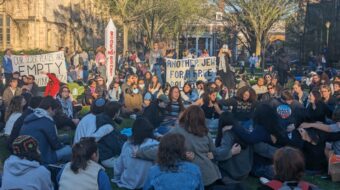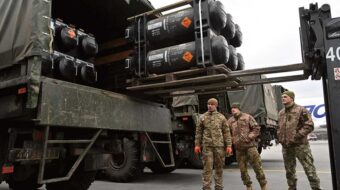
One day soon, demonstrators taking part in the Occupy movement may feel a sudden, unbearable blast of heat. That’s not the weather; it’s the Active Denial System, a new directed-energy weapon developed by the military in 2010. Though originally intended for the Afghanistan War, it could soon be headed to the U.S., under the guise of a “riot control device.”
First off, don’t bother dusting off your copy of The War of the Worlds. This weapon is non-lethal (at least in the immediate sense), and works by firing a high-powered electromagnetic radiation of high-frequency ‘waves.’ Those waves “excite the water and fat molecules in the body, instantly heating it and causing intense pain” in an individual, according to Top Secret Writers.
“You’re not gonna see it, you’re not gonna hear it, you’re not gonna smell it,” said U.S. Marine Colonel Tracy Taffola. “You’re gonna feel it.” And that feeling is apparently so repellent that the immediate reaction is to flee; such was the experience of reporters who attended a presentation of the weapon.
Unlike household microwaves, Taffola added, which penetrate and heat from within, the denial system’s beam’s frequency is absorbed at the surface of the skin, so “there’s an unbearable feeling of intense heat, but no real danger.”
The bizarre device was deployed to Afghanistan for a short time in 2010, but was never actually used.
With its utilization overseas now up in the air, critics of the technology fear its future implementations. The military highlighted the heat rays’ “far-ranging capabilities (a reported reach of about seven football fields),” and in the wake of the weapon’s withdrawal from Afghanistan, they are examining “many different applications” for its potential use.
Many have expressed fears that the system could be used for torture. In fact, Wired Magazine pointed out, “The Active Denial System was rejected for fielding in Iraq due to Pentagon fears that it would be regarded as an instrument of torture.”
And, according to the Globe and Mail, police forces around the country are highly interested in the weapon.
But what people should note in particular about the Active Denial System is its categorization as a “riot control device.” Proponents have suggested it is a “safe method of crowd dispersal,” and an alternative to things like pepper spray – which police officers have viciously used against protesters in the Occupy movement. But is this weaponry simply another form of brutality, waiting to happen? And would it be constitutional?
Its developers have referred to the act of the heat rays hitting a crowd of people as the “goodbye effect.” Many worry that the rays could be used by police as a means of dispersing encampments in various cities that are part of the Occupy movement. Could this be used to try and gag the collective voice of the 99 percent?
If the military’s hope is to use (or misuse) the system for that very purpose, there are steps Occupiers could take to avoid being affected by the heat.
According to Global Security, “Countermeasures against the weapon could be quite straightforward – for example, covering up the body with thick clothes or carrying a metallic sheet – or even a trash can lid – as a shield or reflector. Also unclear is how the Active Denial technology would work in rainy or foggy conditions, where the beam’s energy could be absorbed by water in the atmosphere.”
People may want to start collecting those makeshift shields, because Taffola predicted long-range use of the system, saying, “It could be used across the military spectrum of operations; for perimeter security, crowd control, entry control points, you name it. I think our forces will figure out the many different applications it will have.”
The Pentagon has not yet ordered any of the weapons, but Taffola said that, if asked, they would definitely be ready.
Photo: The Active Denial System sits atop a military vehicle. Elliott Minor/AP












Comments